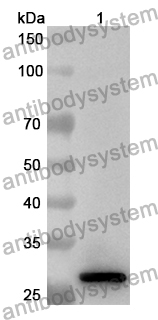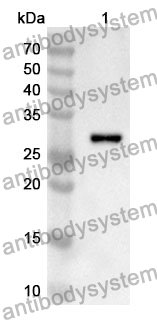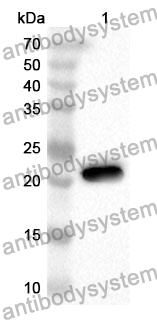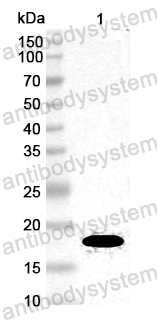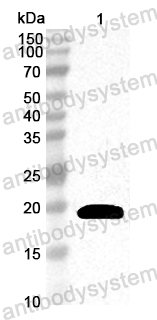Catalog No.
PMD98201
Species reactivity
Mouse
Host species
Rabbit
Isotype
IgG
Clonality
Polyclonal
Immunogen
E. coli - derived recombinant Mouse CD171/L1CAM (Ile20-Thr231).
Tested applications
ELISA: 1:4000-1:8000, IHC: 1:50-1:100, WB: 1:1000-1:4000
Target
Neural cell adhesion molecule L1 (N-CAM-L1) (NCAM-L1) (CD antigen CD171)
Purification
Purified by antigen affinity column.
Accession
P11627
Applications
ELISA, IHC, WB
Form
Liquid
Storage buffer
0.01M PBS, pH 7.4, 50% Glycerol, 0.05% Proclin 300.
Stability and Storage
Use a manual defrost freezer and avoid repeated freeze thaw cycles. Store at 2 to 8°C for frequent use. Store at -20 to -80°C for twelve months from the date of receipt.
Exploring the role of neuronal-enriched extracellular vesicle miR-93 and interoception in major depressive disorder., PMID:38678012
Identification of potential molecular targets for the treatment of cluster 1 human pheochromocytoma and paraganglioma via comprehensive proteomic characterization., PMID:37749499
Exploring the role of neuronal-enriched extracellular vesicle miR-93 and interoception in major depressive disorder., PMID:37398092
Magnetic Separation of Cell-Secreted Vesicles with Tailored Magnetic Particles and Downstream Applications., PMID:37140802
Monitoring of Post-Brain Injuries By Measuring Plasma Levels of Neuron-Derived Extracellular Vesicles., PMID:36324609
Abnormal levels of mitochondrial Ca2+ channel proteins in plasma neuron-derived extracellular vesicles of early schizophrenia., PMID:35867070
β-Amyloid in blood neuronal-derived extracellular vesicles is elevated in cognitively normal adults at risk of Alzheimer's disease and predicts cerebral amyloidosis., PMID:35550625
Antagonistic L1 Adhesion Molecule Mimetic Compounds Inhibit Glioblastoma Cell Migration In Vitro., PMID:35327631
Expression of neural cell adhesion molecule L1 (CD171) in neuroectodermal and other tumors: An immunohistochemical study of 5155 tumors and critical evaluation of CD171 prognostic value in gastrointestinal stromal tumors., PMID:27419370
Preclinical Assessment of CD171-Directed CAR T-cell Adoptive Therapy for Childhood Neuroblastoma: CE7 Epitope Target Safety and Product Manufacturing Feasibility., PMID:27390347
Exosomal Proteins as Diagnostic Biomarkers in Lung Cancer., PMID:27343445
Microarray profiling of L1-overexpressing endothelial cells reveals STAT3 activation via IL-6/IL-6Rα axis., PMID:26484199
Diverse solid tumors expressing a restricted epitope of L1-CAM can be targeted by chimeric antigen receptor redirected T lymphocytes., PMID:24509172
Combined treatment of L1CAM antibodies and cytostatic drugs improve the therapeutic response of pancreatic and ovarian carcinoma., PMID:22210381
L1 stimulation of human glioma cell motility correlates with FAK activation., PMID:21373966
L1CAM regulates DNA damage checkpoint response of glioblastoma stem cells through NBS1., PMID:21297581
L1 is highly expressed in tumors of the nervous system: a study of over 8000 human tissues., PMID:21195422
DOG1 and CD117 are the antibodies of choice in the diagnosis of gastrointestinal stromal tumours., PMID:20716168
Therapeutic antibodies to human L1CAM: functional characterization and application in a mouse model for ovarian carcinoma., PMID:20215505
Stimulation of glioma cell motility by expression, proteolysis, and release of the L1 neural cell recognition molecule., PMID:19874583
Subset of esophageal adenocarcinoma expresses adhesion molecule l1 in contrast to squamous cell carcinoma., PMID:19414364
The L1 cell adhesion molecule is a potential biomarker of human distal nephron injury in acute tubular necrosis., PMID:18059459
Adoptive transfer of chimeric antigen receptor re-directed cytolytic T lymphocyte clones in patients with neuroblastoma., PMID:17299405
Expression profile analysis in multiple human tumors identifies L1 (CD171) as a molecular marker for differential diagnosis and targeted therapy., PMID:16867862
Absence of L1 in pancreatic masses distinguishes adenocarcinomas from poorly differentiated neuroendocrine carcinomas., PMID:16619519
The adhesion molecule L1 (CD171) promotes melanoma progression., PMID:16506207
Adhesion molecules CD171 (L1CAM) and CD24 are expressed by primary neuroendocrine carcinomas of the skin (Merkel cell carcinomas)., PMID:12834484
Reactivity of new adhesion molecules on lymphocytes from patients with chronic graft versus host disease., PMID:12793201
L1 adhesion molecule (CD 171) in development and progression of human malignant melanoma., PMID:12490317

